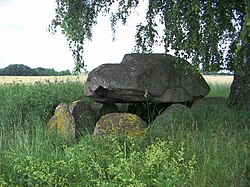Great stone graves near Damerow (Sassen-Trantow)
| Great stone graves near Damerow (Sassen-Trantow) | ||
|---|---|---|
|
The large stone grave Damerow 2 |
||
|
|
||
| Coordinates | Damerow 1 , Damerow 2 | |
| place | Sassen-Trantow , Mecklenburg-Western Pomerania , Germany | |
| Emergence | 3500 to 2800 BC Chr. | |
The large dolmen of Damerow were excavated and restored by Ewald Schuldt in 1968 . The two megalithic systems were built between 3500 and 2800 BC. BC as large stone graves of the funnel beaker culture (TBK). They don't have Sprockhoff numbers . “Neolithic monuments are an expression of the culture and ideology of Neolithic societies. Their origin and function are considered to be the hallmarks of social development ”.
location
They are located in the municipality of Sassen-Trantow, southwest of Greifswald in the Vorpommern-Greifswald district in Mecklenburg-Western Pomerania . From the Pustow - Groß Zastrow road, about 250 m behind Pustow, the unpaved Damerower Weg branches off to the southwest to the hamlet of Damerow. At the end of the slope in the south-east, after a few hundred meters, are the large stone graves Damerow 1 and 2 (numbering according to Ewald Schuldt). Nearby is the expanded dolmen of Damerow.
The Damerow systems are part of a larger group of megalithic systems that extends southwest of Greifswald between Dargelin in the east and Düvier in the west.
description
Preserved graves
Grave 1
The north-south oriented chamber of the large dolmen with access in the south was located in a rolling stone hill . The 1.4 m high, 3.3 m long and 1.9 by 1.4 m wide chamber is largely preserved, but covered again. You can see some bearing stones, including the northern keystone. Only one of the three cap stones is missing. Another has 37 bowls . The floorboard consisted of red sandstone slabs and clay screed .
The archaeological investigation revealed that the facility was re-used by the bearers of the individual grave culture and the spherical amphora culture . In addition to charcoal, animal bones and human bones (including two skulls) and corpse fire, there were two flat axes, two narrow chisels, two spherical amphoras, two tall pots, a blade , a spherical bowl, a bowl, a lance tip and a single burial cup.
Grave 2
The roughly north-south oriented, slightly curved and trapezoidal chamber of the large dolmen with access in the south lay in a narrow, long oval curb stone circle of which six stones were still preserved (14 missing). The 1.5 by 1.2 m high, 5.2 m long and 2.0 by 1.6 m wide geometrically inexact chamber has largely been preserved. One of the four capstones is cut in half and carries bowls . All nine bearing stones of the chamber and all stones of the anteroom or the approximately one meter long corridor have been preserved. The hall consisted of red sandstone slabs and clay screed .
In addition to animal bones and human corpse burns and charcoal , there were four amber beads , three cross cutters , a wide-mouthed pot, a curved point and a blade .
The destroyed grave 3
In the collection of the University of Greifswald there are six undecorated ceramic shards that come from a destroyed large stone grave , probably excavated by Franz Klinghardt . There are no details about the grave itself.
See also
literature
- Hans-Jürgen Beier : The megalithic, submegalithic and pseudomegalithic buildings as well as the menhirs between the Baltic Sea and the Thuringian Forest. Contributions to the prehistory and early history of Central Europe 1. Wilkau-Haßlau 1991, p. 24.
- Luise Lorenz: Ceramic lifetimes and the useful life of northeast German megalithic graves. In: Martin Hinz, Johannes Müller (eds.): Settlement, trench works, large stone grave. Studies on the society, economy and environment of the funnel cup groups in northern Central Europe (= early monumentality and social differentiation. Volume 2). Rudolf Habelt Verlag, Bonn 2012, ISBN 978-3774938137 , pp. 61-86 ( online ).
- Ingeburg Nilius : The Neolithic in Mecklenburg at the time and with special consideration of the funnel beaker culture. Museum of Prehistory and Early History, Schwerin 1971,.
- Ewald Schuldt : The Mecklenburg megalithic graves. Research on their architecture and function. VEB Deutscher Verlag der Wissenschaften, Berlin 1972, p. 131.
- Ewald Schuldt: The dolmen of Damerow, district Demmin In: Yearbook of the ground monument preservation Mecklenburg 1970. (1971) P. 91-110.
- Ernst Sprockhoff : Atlas of the megalithic tombs of Germany. Part 2: Mecklenburg - Brandenburg - Pomerania. Rudolf Habelt Verlag, Bonn 1967, pp. 81–82.
Web links
- Description and pictures Damerow 1
- Description and pictures Damerow 2
- The extended dolmen nearby (but not described here)
Individual evidence
- ↑ J. Müller In: Varia neolithica VI 2009 p. 15




